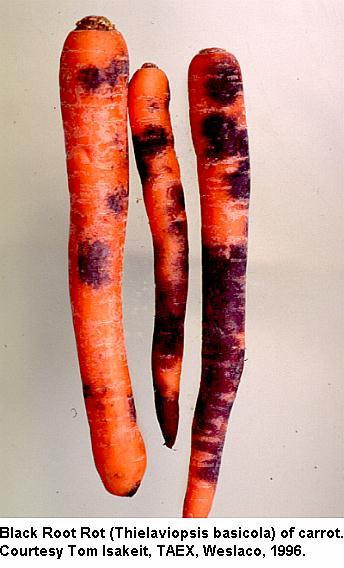What Is Carrot Black Root Rot: Learn About Black Root Rot Of Carrots


Black root rot of carrots is a nasty fungal disease that plagues gardeners around the world. Once established, carrot black root rot is difficult to eradicate and chemicals are of little use. However, there are steps you can take to minimize the damage and slow the spread of disease. Read on to learn more about black root rot in carrots.
Signs of Black Root Rot of Carrots
Carrots with black root rot typically display a black or brown, decayed ring at the top of the carrot, at the point where the leaves are attached. The disease results in wilting, stunted growth and carrots that break off in the soil when pulled. Carrot black root rot can affect carrots at any stage of growth. It can show up on seedlings, and may appear during storage, evidenced by decay and black lesions that can spread to healthy carrots.
Causes of Carrot Black Root Rot
Carrot black root rot fungus is often present in infected seeds. Once established, spores can live in plant debris as long as eight years. The disease is favored by wet leaves and damp weather, especially when temperatures are above 65 degrees F. (18 C.) Sprinkler irrigation and rainfall contribute to spread of root rot in carrots. Additionally, black root rot of carrots is more common in alkaline soil.
Treating Carrots with Black Root Rot
Since treatment isn’t really an option, preventing black root rot of carrots is important. Start with certified disease-free seeds. If that’s not possible, soak seeds in hot water, 115 to 150 degrees F. (46-65 C.), for 30 minutes before planting. Maintain soil at a pH level near 5.5 to reduce infections. (Soil tests are available at most garden centers). There are several ways to lower pH, including addition of aluminum sulfate or sulfur. Your local cooperative extension service can help you determine the best method. Practice crop rotation. Avoid planting carrots or carrot relatives in the infected soil for three or four years. These include:
Water in the morning so the carrot leaves have time to dry completely for evening. If possible, water at the base of the plants. Avoid overhead irrigation whenever you can. Dispose of infected carrots and plant debris immediately after harvest. Burn them or place them in a tightly sealed container. Fungicides aren’t generally very helpful, but they may provide some level of control when applied as soon as symptoms appear.
Gardening tips, videos, info and more delivered right to your inbox!
Sign up for the Gardening Know How newsletter today and receive a free copy of our e-book "How to Grow Delicious Tomatoes".

A Credentialed Garden Writer, Mary H. Dyer was with Gardening Know How in the very beginning, publishing articles as early as 2007.
-
 ‘Coral Charm’ Peony Care For Sublime Semi-Double Peonies With Lush Salmon Pink Flowers
‘Coral Charm’ Peony Care For Sublime Semi-Double Peonies With Lush Salmon Pink FlowersPeonies are known for their soft baby pink or magenta tones, but if plushy coral blooms are your thing, here’s our guide to the ultimate ‘Coral Charm’ peony care
By Tonya Barnett
-
 How To Grow Seeds Quickly: 8 Expert Tricks For Fast Flowers & Crops
How To Grow Seeds Quickly: 8 Expert Tricks For Fast Flowers & CropsIt's never too late to start growing! Jump-start your flower or vegetable garden with these pro tips and tricks for germinating seeds in record time.
By Amy Grant